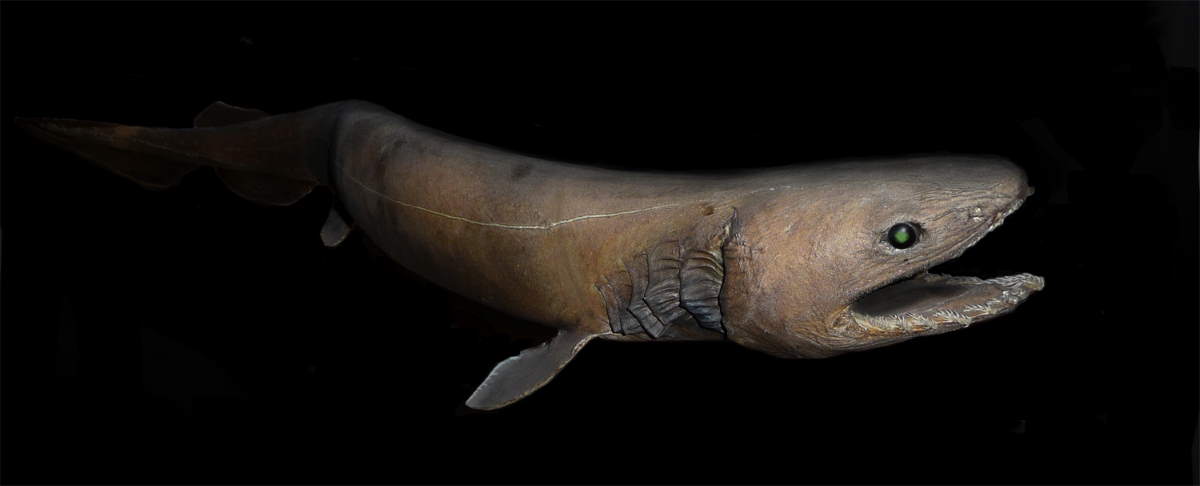Young software developer Neal Agarwal (Twitter: @nealagarwal) created an amazing interactive visualization showing life in the depth of the oceans. Named “The Deep Sea” (click here to see the visualization), the interactive webpage shows the living depths and also the maximum diving points of various animals. Be prepared to be amazed!
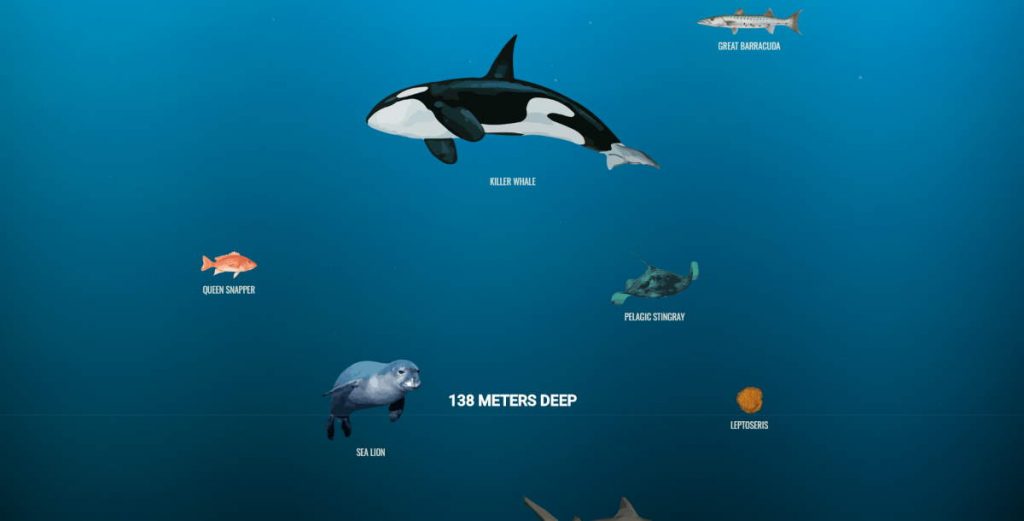
The deep sea: living and/or dive depths of some animals and plants
Please keep in mind that the animals and plants listed below are not the only lifeforms to live in these depths – they are just a few examples.
Up to 14 meters (46 feet) deep
Atlantic salmon, Manatee (large, fully aquatic, mostly herbivorous marine mammals also known as sea cows), striped bass, staghorn coral
Up to 40 meters (131 feet) deep
Polar bear, European pilchard, barramundi (Asian sea bass), clownfish
Up to 66 meters (217 feet) deep
Velvet crab, blue tang, Atlantic cod, spiny dogfish, leafy sea dragon, mahi-mahi (or common dolphinfish, a surface-dwelling ray-finned fish found in off-shore temperate, tropical, and subtropical waters worldwide)
Up to 92 meters (302 feet) deep
Flounder (a group of flatfish species), spotted bass, beluga whale, bluefish
Up to 127 meters (417 feet) deep
Great barracuda, killer whale, queen snapper, pelagic stingray
Up to 170 meters (558 feet) deep
Sealion, leptoseris, bull shark, black drum, green sea turtle
Up to 200 meters (650 feet) deep
Atlantic mackerel, dentex
Ocean twilight zone begins
The ocean twilight zone lies 200 to 1,000 meters (about 650 to 3,300 feet) below the ocean surface, just beyond the reach of sunlight.
Also known as the midwater or mesopelagic, the twilight zone is cold and its light is dim, but with flashes of bioluminescence (light produced by living organisms). The region teems with life. Recent studies suggest that the biomass of fish in the twilight zone maybe ten times greater than previously thought, more than in all the rest of the ocean combined.
Up to 240 meters (558 feet) deep
Thick-billed murre dive, haddock, wolf eel (a species of wolffish from the North Pacific), chain catshark
Up to 275 meters (902 feet) deep
Kelp, terrible claw lobster, olive ridley sea turtle, great white shark
Up to 310 meters (1,017 feet) deep
Bottlenose dolphin dive, Cockatoo squid
Up to 332 meters (1,090 feet) deep
Gummy shark, human dive
At 332.35 meters, this is the deepest any human has scuba-dived. Set in 2014 by Ahmed Gabr (born 9 November 1972), an Egyptian scuba diver. As of December 2019, Gabr holds the Guinness World Records for both The Deepest Scuba Dive (Male) and The Deepest Scuba Dive in Sea Water. Ahmed dived to a depth of 332.35 meters (1,090.4 ft).
Up to 400 meters (1,312 feet) deep
Blue shark, firefly squid
Up to 450 meters (1,476 feet) deep
Bigeye tuna
Up to 500 meters (1,640 feet) deep
Sea angel, chinook salmon, mako shark
Up to 550 meters (1,804 feet) deep
Emperor penguin dive, swordfish
Up to 600 meters (1,969 feet) deep
Nautilus, sunfish
Up to 650 meters (2,133 feet) deep
Bamboo coral, Japanese spider crab (the largest known crab with a leg span of up to 3.8 meters / 12 feet 5.61 inches)
Up to 700 meters (2,297 feet) deep
Coelacanth
Dubbed “living fossil”, the coelacanth, which is related to lungfishes and tetrapods, was believed to have been extinct since the end of the Cretaceous period (from 145 million years ago -mya- to the beginning of the Paleogene Period 66 mya). The Cretaceous (along with the Mesozoic) ended with the Cretaceous-Paleogene extinction event, a large mass extinction in which many groups, including non-avian dinosaurs.
But, on December 23, 1938, a living specimen was found off the east coast of South Africa, off the Chalumna River (now Tyolomnqa). Between 1938 and 1975, 84 specimens were caught and recorded.
A team of divers off the coast of South Africa comes face to face with a Coelacanth.
Up to 750 meters (2,461 feet) deep
King crab
Up to 800 meters (2,625 feet) deep
Giant pacific octopus, giant oarfish (the longest bony fish on Earth, although they commonly measured up to 3 meters/9.8 feet in total length, they can grow a record length of 11 meters/36 feet)
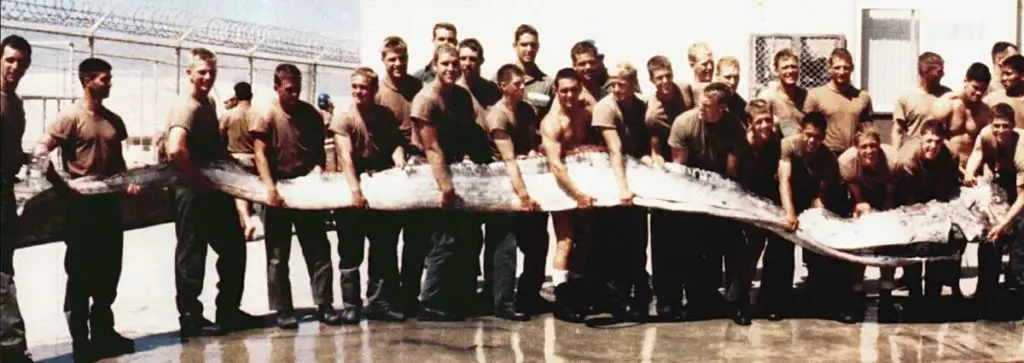
Up to 850 meters (2,789 feet) deep
Monkfish, Pacific cod
Up to 900 meters (2,953 feet) deep
Marrus orthocanna, vigtorniella worm
Up to 950 meters (3,117 feet) deep
Sperm whale dive, leatherback sea turtle
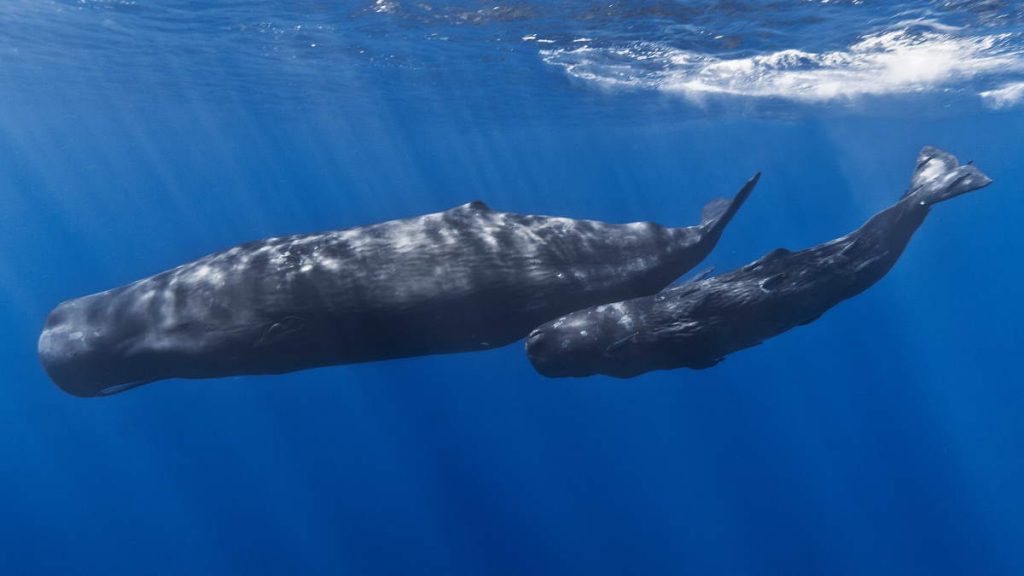
Related: 20 Amazing Sperm Whale Facts
Up to 1000 meters (3,281 feet) deep
Baird’s beaked whale, also known as the four-toothed whale
Ocean midnight zone begins
The ocean’s midnight zone, also known as the Bathyal zone is a region between one and four kilometers (3,281 to 13,100 feet) deep, where no sunlight at all penetrates the frigid water. With no light, there is no growth of plants or phytoplankton (because of the lack of sunlight necessary for photosynthesis) – all animals are thus predators or scavengers.
Because of the lack of light, some species do not have eyes. Many deep-sea creatures cope by creating light themselves – also known as bioluminescence.
Up to 1,100 meters (3,609 feet) deep
Anglerfish (which have a large bioluminescent lure used to attract prey in the darkness), phronima, orange roughy (which is notable for its extraordinary lifespan, attaining over 200 years, one of the longest-living animals in the world. Deep-sea life often have elongated life spans.)
Up to 1,200 meters (3,937 feet) deep
Blobfish, the frilled shark, great white shark.
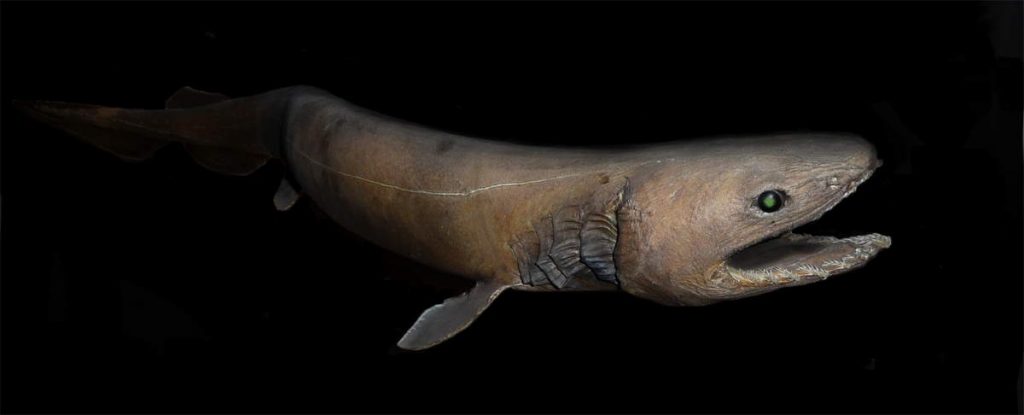
Up to 1,300 meters (4,265 feet) deep
Goblin shark – they sometimes called a “living fossil”, it is the only extant representative of the family Mitsukurinidae, a lineage some 125 million years old.
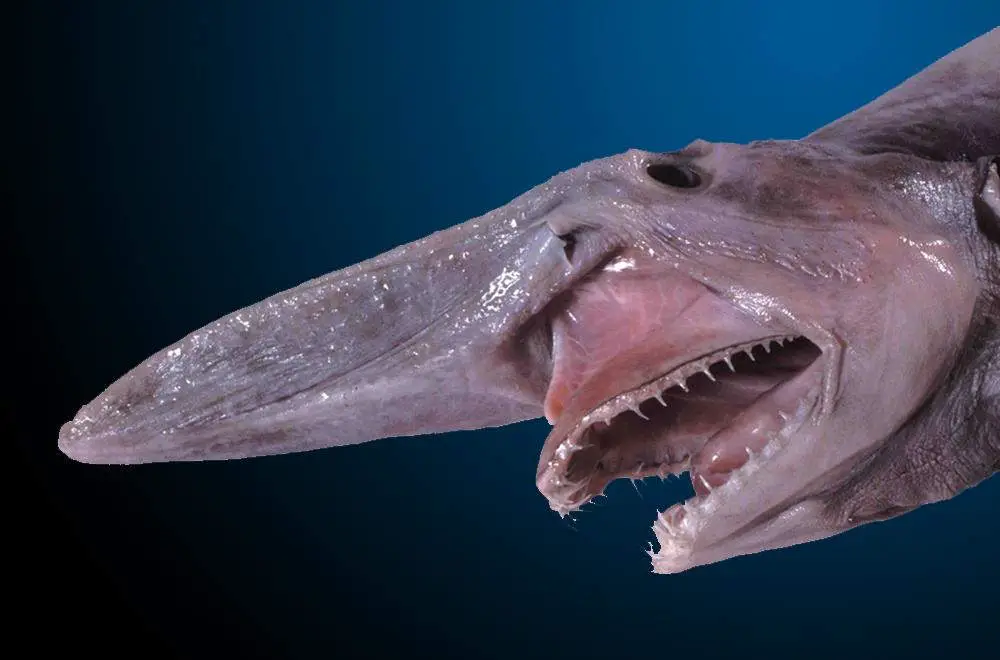
Up to 1,400 meters (4,593 feet) deep
Bubblegum coral, hatchet fish
Up to 1,500 meters (4,921 feet) deep
Dragonfish, big red jellyfish (many deep-sea species use the color red as camouflage since it is the first color to leave the spectrum as you dive deeper)
Up to 1,600 meters (5,249 feet) deep
Greenland halibut, giant tube worm ( giant tube worms get their nutrients from hydrothermal vents which are formed from seawater passing through extremely hot volcanic rocks. Hydrothermal vents release that are toxic to most animals, but giant tube worms can tolerate extremely high hydrogen sulfide levels.)
Up to 1,800 meters (5,906 feet) deep
Yeti crab, sixgill shark, narwhal dive (a medium-sized toothed whale that possesses a large “tusk” from a protruding canine tooth)
Up to 2,000 meters (6,562 feet) deep
Jewel squid, sea pen, telescope octopus (it is transparent, almost colorless, and has 8 arms. It is the only octopus to have tubular eyes, hence the reason it is commonly referred to as telescope octopus), Mobula ray.
Up to 2,200 meters (7,217 feet) deep
Giant isopod (meals are scarce in the deep-sea, so many deep-sea creatures are adapted to long periods of famine – one giant isopod has been known to survive over 5 years without food in captivity), Greenland shark, colossal squid (largest known squid species, they can grow up to 10 meters / 33 feet, and weigh up to 700 kg / 1.543 lbs)
Up to 2,400 meters (7,874 feet) deep
Barreleye fish, elephant seal dive
Up to 2,600 meters (8,530 feet) deep
Gigantactis, chimaera
Up to 2,800 meters (9,186 feet) deep
Squidworm, black swallower, viperfish
Up to 3,000 meters (9,843 feet) deep
Scaly-foot snail, vampire squid, headless chicken fish (Enypniastes, also known as the “swimming sea cucumber”), zombie worm, Cuvier’s beaked whale dive – the deepest diving mammal
Even the vampire squid is just one of many species out of sight and out of mind that threatened by human activities far away from the part of the ocean where they live.
Up to 3,200 meters (10,500 feet) deep
Glass sponge, gulper eel (also known as the pelican eel, a deep-sea fish rarely seen by humans), cosmic jellyfish, spotlight loosejaw (Malacosteus)
Up to 3,400 meters (11,155 feet) deep
Harp sponge, cookiecutter shark (it is named after the cookie-shaped wounds that it leaves on the bodies of its prey. This small fish is also known as the cigar shark because of its body shape)
Up to 3,600 meters (11,811 feet) deep
Lizardfish, flabby whalefish
The average depth of the ocean
3,688 meters (12,100 feet): the average depth of the ocean (according to NOAA, some sources, for example, National Geographic give a slightly different number)
Titanic’s resting deep
The wreck of the RMS Titanic lies at a depth of about 3,800 meters (12,500 feet).
Up to 4,000 meters (13,123 feet) deep
Patagonian toothfish (have antifreeze proteins in its tissues to prevent freezing in sub-zero temperatures), the dumbo octopus
Abyssal zone begins
The abyssal zone is the portion of the ocean deeper than about 4,000 meters (13,123 feet) and shallower than about 6,000 meters (20,000 feet). The zone is defined mainly by its extremely uniform environmental conditions, as reflected in the distinct life forms inhabiting it.
The temperature here is near freezing and very few animals can survive the extreme pressure.
“Abyss” derives from the Greek word “ἄβυσσος”, meaning “bottomless sea.”
Some sources start the abyssal zone from 2,000 meters (6,600 feet) and others from 3,000 meters (9,850 feet).
Up to 4,050 meters (13,287 feet) deep
Atolla jellyfish
Up to 4,600 meters (15,092 feet) deep
Sea pig, megamouth shark (it is one of the largest shark species with some reaching 8 meters / 26 feet long)
Up to 4,700 meters (15,420 feet) deep
Ninja lanternshark (Etmopterus benchleyi)
Up to 4,800 meters (15,748 feet) deep
Fangtooth, tripod fish
Up to 5,000 meters (16,404 feet) deep
Caridea
Up to 5,100 meters (16,732 feet) deep
Faceless fish
Up to 5,300 meters (17,388 feet) deep
Amphipoda
Up to 5,500 meters (18,044 feet) deep
Brittle star
Up to 5,600 meters (18,373 feet) deep
Abyssal spider fish
The Hadal Zone begins
The hadal zone (named after the realm of Hades, the underworld in Greek mythology), also known as the hadopelagic zone, is the deepest region of the ocean lying within oceanic trenches. The hadal zone is found from a depth of around 6,000 to 11,000 meters (20,000 to 36,000 feet).
Deep-sea trenches form by a process called “subduction” where the Earth’s tectonic plates meet and push together. Life here is sparse – the extreme conditions make survival difficult, but still not impossible.
So little is known about life in these deep environments. Almost every expedition uncovers something new.
More people have been to the Moon than the Hadal Zone.
USS Johnston (DD-557) shipwreck – the deepest shipwreck ever found
The USS Johnston sunk in WWII. Its wreck was discovered on October 30, 2019, what is believed to be the deepest shipwreck ever located at 6,220 meters (20,406) deep in the Philippine Trench.
Up to 6,800 meters (22,310 feet) deep
Grenadier
Up to 6,900 meters (22,638 feet) deep
Chiton
Up to 7,200 meters (23,622 feet) deep
Comby jelly – they have been around for 500 million years. Despite looking like jellyfish, they are not closely related.
Up to 8,200 meters (26,903 feet) deep
Hadal snailfish
Up to 8,400 meters (27,559 feet) deep
Cusk eel
The height of Mount Everest
So far, you have scrolled the height of Mount Everest (8,848 meters / 29,029 feet).
Up to 10,300 meters (33,793 feet) deep
Hadal amphipod
Mariana trench – the deepest point of the Earth’s oceans
On January 23, 1960, about 9 years before the moon landing, humans went where they never had before.
The Swiss oceanographer and engineer Jacques Piccard (28 July 1922 – 1 November 2008) and the American oceanographer, explorer and marine policy specialist Don Walsh (born November 2, 1931) reached the floor of the Mariana Trench (the Challenger Deep) using a special submarine named Trieste.
The submarine used a re-breather system that would later be used in spacecraft. There was barely enough space inside the pressure sphere for both of them.
The descent progressed without incident until 9,150 meters (30,000 feet), when the crew heard a loud crack that shook the entire vessel. They had no idea what it was.
Even at these unfathomable depths, Jacques and Don could still see life out the window. Life can survive in unimaginable environments.
The immense pressure of the deep sea means any mistake would mean certain death. They continued the dive, however, and after 4 hours and 47 minutes of anxiety and claustrophobia, they finally touched down in “snuff-colored ooze” at 10,916 meters (35,813 feet).
On March 26, 2012, Canadian film director James Cameron (born August 16, 1954) has reached the bottom of the Mariana Trench in the submersible vessel Deepsea Challenger. He became the first person to do this in a solo descent and is only the third person to do so ever.
On the 23rd of January 1960, US navy lieutenant Don Walsh and Swiss engineer Jacques Piccard were the first people to dive to the bottom of the ocean, the Challenger Deep in the Mariana Trench. These men were true pioneers and the journey to this amazing record in 1960 was not an easy one.
The depth of the descent was measured at 10,916 meters (35,813 feet); later, more accurate, measurements during 1995 found the Mariana Trench to be slightly less deep at 10,911 meters (35,797 feet).
Data suggests that microbial life forms thrive within the trench.
Sources
- “Ocean Twilight Zone” on the Woods Hole Oceanographic Institution website
- Ahmed Gabr on Wikipedia
- Coelacanth on Wikipedia
- “Welcome to the Midnight Zone” on aquarium.co.za
- Goblin shark on Wikipedia
- Cookiecutter shark on sharksider.com
- Hadal zone on Wikipedia
- Jacques Piccard on Wikipedia
- Don Walsh on Wikipedia
- How Many Elephants are Left in the World in 2025? - August 17, 2025
- Moon Landings: All-Time List [1966-2025] - February 2, 2025
- What Is Max-Q and Why Is It Important During Rocket Launches? - January 16, 2025
